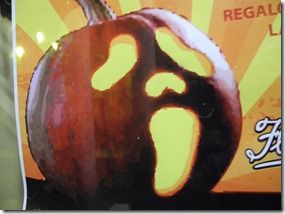Halloween has been celebrated in Canada for many generations. Traditions have changed over the years and it has become more commercial than in previous decades. During the 1940s, the treats and costumes were derived more from the homes of the children, rather than purchased in shopping malls.
The following quote is from the book “Arse Over Teakettle.” This passage tells about the preparations for a child going “shelling out” for treats in 1945, the years that the Second World War ended.
As Halloween approached, the display of penny candy in the window at the School Store was magically transformed. Orange and black jelly beans and jujubes appeared, along with licorice twists, jelly babies, and licorice candy shaped like a man’s smoking pipe, the top of the bowl coated with red sparkles to simulate the appearance of a pipe had been lighted. Small candy pumpkins with grinning faces were enticing. I pressed my face longingly against the window, my brow frowned in concentration, as if deciding which candies to buy before I entered the store. However, it was all in vain, as I had no money to spend.
The last few days before the end of the month, we prepared our classroom for Halloween. We cut jack-o’-lanterns from orange construction paper. Miss Campbell hung them in the windows, the sunlight from outside shining through their slanted eyes and evil, toothy grins. We painted black cats on newsprint, the felines’ spines arched, as if hissing at the spirits of the night. In addition, we listened to ghost stories and eerie poems.
Shortly before dismissal time one day, Miss Campbell opened a bag of “kiss candies.” This was an unusual occurrence, as schools were serious places not easily given to frivolity. The kiss candies were those that Loblaws sold, orange with licorice-flavoured centres. Delicious and easy to chew, they were not like the brown molasses variety that required softening in the mouth before chomping on them. Otherwise, they pulled the molar from the jawbone. We each received one “kiss” from Miss Campbell, grateful that accepting her kisses did not compromise our manly virtues. On the way home from school, we discussed our costumes and gleefully shared information concerning the homes that doled out the best treats.
Parents usually insisted that their children were at least eight years old before they were allowed to go out for Halloween unaccompanied. As I was seven, my mother ordered me to remain with my brother. Most adults remember various milestones in their lives, such as coming of age to learn to drive a car, attend restricted movies, or legally consume alcohol. Many forget milestones that occurred earlier in their lives: going unaccompanied by an adult or older brother to a movie, shelling-out, or the CNE.
Before supper, Ken and I carved the pumpkin my mother had bought the day before. Next, we assembled our costumes in preparation for the evening’s fun. Our parents had not purchased our outfits in stores. We improvised, employing whatever clothing and objects were at hand. Some years, we created disguises by painting our faces. Other years we used crayons to draw faces on paper grocery bags and cut out eye and mouth holes. On Halloween night, the sweat on our foreheads and moisture around our mouths often changed parts of the paper to mush. Rain was another threat to these paper masks.
There were alternatives. A strip of black cloth with eyeholes became a Lone Ranger mask, or that of a bank robber or pirate. Old bedsheets transformed us into ghosts, and worn-out clothes created a hobo’s attire. Sometimes our costumes changed us into girls, elderly ladies, or witches. The head of a discarded mop simulated a wig. Sometimes we were cowboys, Indians, sailors, priests, angels, or fairies. However, most important of all was the size and strength of the bag that we carried to contain the goodies received at the houses. An old pillowcase was the best, as it was large and strong. There were no plastic grocery bags available in this decade.
This passage is from the book Arse Over Teakettle, a story about a boy coming of age in Toronto during the post-war years in Toronto.
